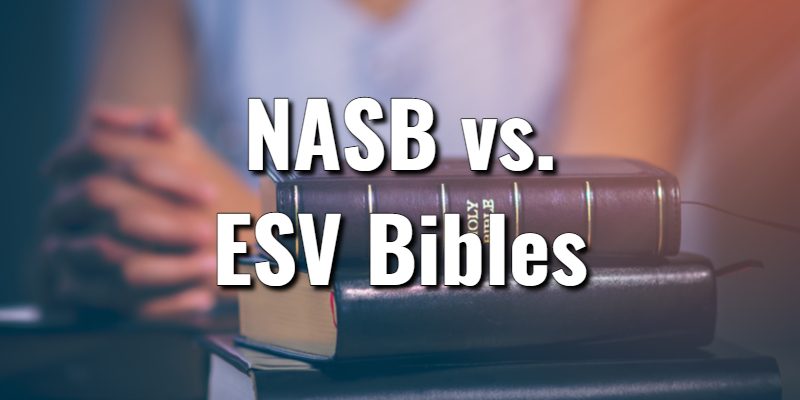This is part of Lord’s Library’s Bible Comparison Series. Our editors explore the NASB vs. ESV Bibles so you can understand the major differences between each translation.
 When looking for a new Bible for yourself or as a gift, comparing the different Bible versions is an ideal first step. It’s also important that one considers the various Christian Church denominations when Bible shopping so the reader can be comfortable with their translation’s version of English. Some churches mandate a precise edition as well, while others may be curious about which version of the manuscript their favorite Bible translation comes from.
When looking for a new Bible for yourself or as a gift, comparing the different Bible versions is an ideal first step. It’s also important that one considers the various Christian Church denominations when Bible shopping so the reader can be comfortable with their translation’s version of English. Some churches mandate a precise edition as well, while others may be curious about which version of the manuscript their favorite Bible translation comes from.
.If you’ve ever asked the question “What’s the difference between the NASB vs. ESV Bibles?” you’ve come to the right place. It’s in that spirit that our editors compiled this short resource by first offering a simple description of each Bible version, and then a comparison that highlights key contrasts. For each of the two Bible versions compared, Lord’s Library editors included links to our directories of the best editions, as well as the most popular products.
NASB vs. ESV Bibles
What is the NASB (New American Standard Bible)?
The New American Standard Bible is an interesting Bible because it is the most widely embraced literal and accurate Bible translation created in the 20th century. First published in its entirety in 1971, the NASB aims to be true to the original languages of the Bible while being understandable. This Bible translation was produced from the need for a contemporary word-for-word Bible translation that existed at that time.
The greatest quality of the NASB is its fidelity to the Hebrew, Aramaic, and Greek of which it came. It’s impressive how it is able to merge this accuracy with readability that is accessible to most modern readers. Modern criticism cites that while it’s easy to read and mainly accurate to the best manuscripts available, it is devoid of the literary excellence and passion of the King James Version.
What is the ESV Bible (English Standard Version)?
Of the more modern, meaning-for-meaning translated Bibles, the English Standard Version most closely walks the line between literal, word-for-word translating and attempting to convey the meaning above all else. The first complete ESV Bible was published in 2001 by Crossway, as a revision of the Revised Standard Version. The team of over 100 evangelical scholars and pastors had a unique philosophy in translating this Bible: “Emphasizes word-for-word accuracy, literary excellence, and depth of meaning.”
The ESV remains a popular choice among evangelical churches. That’s because of its unique ability to walk that line between honoring the literal translations that preceded it (such as the RSV) while conveying meaning and modern language in an accessible way. This view is not shared by all though, as some believe that while pursuing this goal the translators have made a few grave errors in theology.
NASB vs. ESV Bibles; What’s the Difference?
The New American Standard Bible is a revision of the earlier American Standard Version. It was created as an alternative to the Revised Standard Version because many believed it to be too theologically liberal. In the same way, the English Standard Version has been known to be a theologically conservative Bible just as the NASB strives to be. In fact, the ESV was a revision of the Revised Standard Version.
Seeing the need for a literal, modern version of the English Bible, translators of the NASB sought to produce a contemporary English Bible while maintaining word-for-word translation. In cases where word-for-word literalness was determined to be unacceptable for modern readers, changes were made in the direction of more current idioms. In some such instances, the more literal renderings were indicated in footnotes. The ESV likewise maintains a word-for-word translation while being cognizant of the needs of its modern readers.
The NASB is known to be reliable in the original languages. It includes printing of verses as individual units (although more recent editions are available in paragraph format). The ESV likewise strived to hold to the original languages of the Scriptures as much as possible. The ESV used Biblica Hebraica Stuttgartensia as its basis for the Old Testament and the UBS Greek for its New Testament. The NASB used Biblica Hebraica Suttgartensia and Biblica Hebraica Quinta for its Old Testament and Novum Testamentum Graece for it’s New Testament.
Lord's Library participates in affiliate programs. We may make a small commission from products purchased through this resource.
- What Does the Bible Say About Discernment? With Key Scriptures - July 19, 2024
- What Does the Bible Say About Disobedience? With Key Scriptures - July 19, 2024
- 1 Timothy 1:12 Meaning: Commentary on an Important Scripture - July 11, 2024














